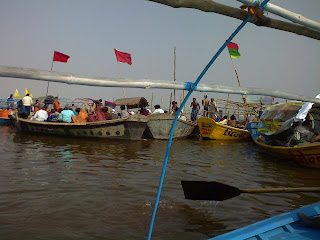Considered as the abode of Lord Shiva, Varanasi is situated on the banks of River Ganges, which is believed to have the power of washing away all of one's sins. As pundits here will tell you, whatever is sacrificed and chanted here or given in charity reaps its fruits thousand times more than those good deeds performed at other places because of the power of that place. It is believed that three nights of fasting in Varanasi city can reap you rewards of many thousands of lifetimes of asceticism!
Varanasi is the oldest city of the world. Varanasi is more than 3000 years old and is famous as the city of temples. In Varanasi, there are temples at every few paces. Looking at the number of temples in Varanasi, it is hard to believe that a large number of them were demolished during the medieval times. Jyotirlinga Visvanatha Temple or Golden Temple, rebuilt in 1776, is dedicated to Lord Shiva. The Jnana Vapi well (meaning 'Well of Wisdom) is believed to have been dug by Lord Shiva himself. It is believed that the majestic Alamgir mosque has replaced one of the most ancient shrines known as the temple of Bindu Madhava. The thirty-three hundred million shrines fill one with awe and wonder with sheer numbers.
The Ganga Ghats (river front) are the most popular pilgrimage spot of Varanasi and are centers of music and learning. There is a great tradition of Yatras in the holy city of Kashi and the most sacred path is that of Panchkoshi Parikrama, the fifty-mile path with a radius of five miles that cover 108 shrines along the way, with Panchakoshi Temple as its main shrine. Other popular pilgrimage route is Nagara Pradakshina, which covers seventy-two shrines along the way. Since time immemorial Varanasi is a great center of learning. The holy city has been a symbol of spiritualism, philosophy and mysticism for thousands of years and has produced great saints and personalities like Guatama Buddha, Mahavira, Kabir, Tulsi Das, Shankaracharaya, Ramanuja and Patanjali.
Varanasi is said to be the oldest surviving city of the world. Varanasi is also called as Kashi or Benaras. Being the most venerated pilgrim place in Hindu religion, Varanasi is said to be a museum of temples. Also called the city of temples, Varanasi is home to about 2,000 temples. People from all parts of India as well as the world come to Varanasi to visit these temples, making the holy temples of Varanasi amongst the most visited temples in India. Many important and famous temples are located at Ganga Ghats (river front), adding to the religious value of the holy river, Ganges.
Most of the temples that are located on the Ganga Ghats are old and date back to the medieval period. According to legends the first Siva Jyotirlinga, the fiery pillar of light, came through the earth here and flared into the sky. Therefore Varanasi is also called Kashi, "the City of Light." The Kashi Vishwanath temple, located near the Ganga Ghats, is the most famous and important temple of Varanasi. In this temple resides the guardian of the holy city, Lord Shiva. Other important temples of Varanasi are the new Vishwanath temple, the Sankat Mochan temple, the Durga temple, the Kal Bhairav temple and the Mritunjaya temple.
Distance From: | |
| Jaunpur: | 65 km |
| Chunar: | 40 km |
| Sarnath: | 10 km |
| Kaushambi: | 180 km |


0 comments:
Post a Comment